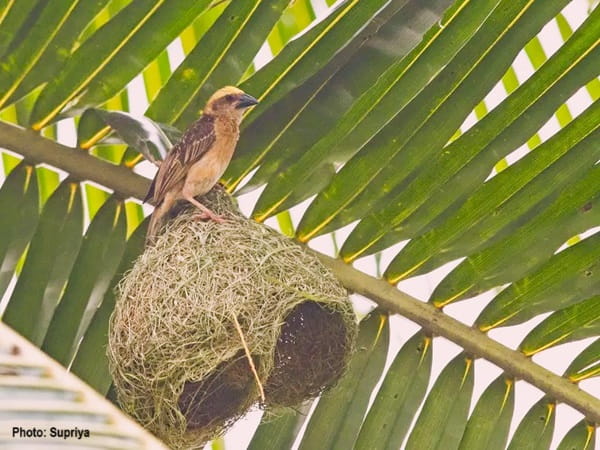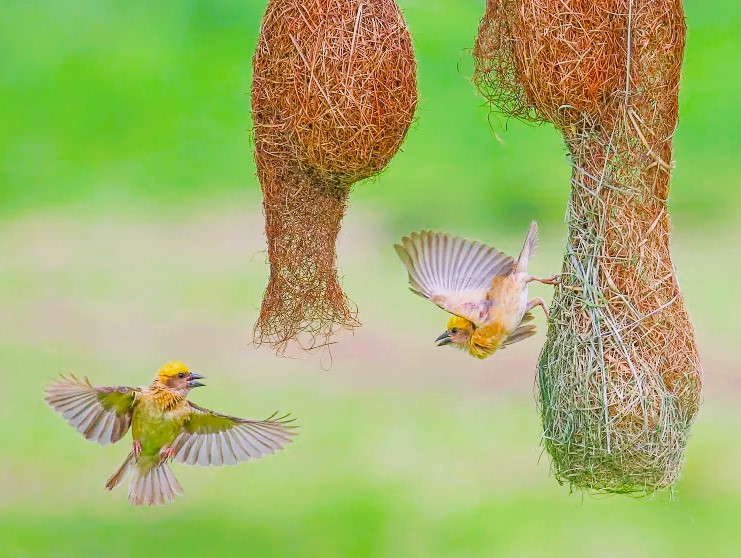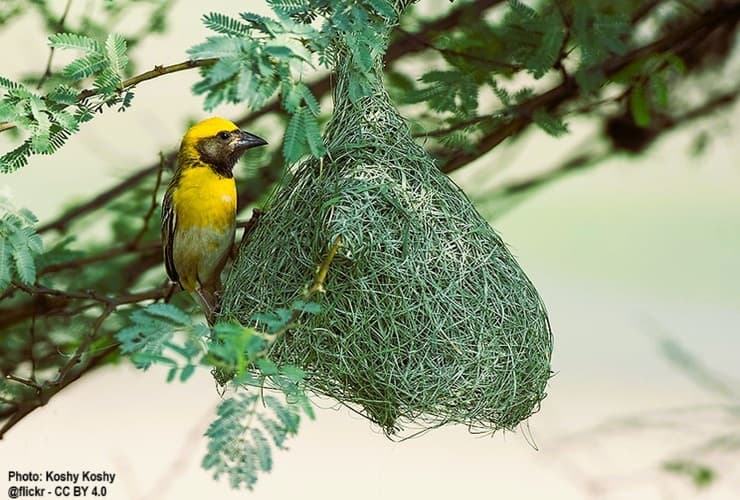Life Amid the Palms

Nov. 2024 - Welcome!

Where do Baya Weaver Birds Live?
And Why Do We Want to Know?
Baya Weaver birds have a super talent! What does it have to do with palm trees?
 Baya Weaver Bird Sits Atop a Nest in a Palm Tree
Baya Weaver Bird Sits Atop a Nest in a Palm TreeThese creative birds are up in palm trees building a substantial home for their mate & offspring.
What is the Unique Behavior of the Baya Weavers?
What's amazing about this bird, is the way it prepares for nestlings.
They build their nest up high in tall palms or thorned trees. They're also routinely attached to palm frond petioles that extend out over water.
 The Male Baya Weaver Bird
The Male Baya Weaver BirdThe purpose for the height is keeping away predators, which may find the nests grueling to reach. Still, sometimes lizards or rodents manage to get there. Crows are the most common successful predator. It's easier if you can fly!
These birds make a hanging nest attached to their chosen tree. They particularly like the tallest palm trees of the area. All of which grow upward from 70ft/21m to 100ft/30m. Like:
- Coconut Palm Trees (Cocos nucifera)
- Toddy Palms (Phoenix sylvestris)
- Giant Fishtail Palm (Caryota gigas)
- Or the Nibung Palm (Oncosperma tigillarium).
 Male Baya Weaver Checking Out a Palm Tree for His Possible Nest Construction
Male Baya Weaver Checking Out a Palm Tree for His Possible Nest ConstructionWhere do Baya Weaver Birds Live?
They're residents in India and Southeast Asia, where they find tall palms in suitable climates.
Even though they look for tall trees to build their nests, they fly into grasslands, farmlands & scrub forests. Looking for seeds & insects to scoop into their cone-shaped beak. While flying around with their flocking buddies.
Baya Weavers are about the size of an average sparrow. Very sociable & animated within their own flock.
 Female Baya Weaver is Not as Colorful as a Male
Female Baya Weaver is Not as Colorful as a MaleThe Baya Weaver Birds' Nest Construction
Male Baya Weavers choose their nesting site within a colony of about 20-30 other nests.
 A Colony of Baya Weavers Nesting in a Palm Tree
A Colony of Baya Weavers Nesting in a Palm TreeThey build nests with strips torn from palm fronds. Adding in rough grasses and rice plant leaves. Weaving & knotting them all together.
The most intelligent Baya Weavers add mud & dung globs to help impress a lady! But its practical purpose is strength, so storms won't destroy it during Monsoon season.
 Such Talent! The Male Has Begun Construction
Such Talent! The Male Has Begun ConstructionMales pause construction midway to begin looking for a mate.
 It's Time to Vie For Female Attention
It's Time to Vie For Female AttentionOnce a connection is made with a female, the male gets back to nest work & constructing the tube-like entrance. He'll make over 500 trips back and forth to gather needed materials, over around 18 days.
 He's About to Restart His Nest-Building Project
He's About to Restart His Nest-Building ProjectWhen his mate moves in, she'll add more clumps of mud, and some inner redesign of her own.
Are weaver birds intelligent? It may now seem so, after looking at their construction product!
Baya Weaver's Endangerment Success
Deforestation is a problem that had endangered the Baya Weaver Bird. With limited places for flock nesting, their nests were seen less frequently over time. Until almost nearing extinction.
Until 1972, when India's Wild Life (Protection) Act came into the picture. Chapter IV relates to "Protected Areas" - providing animal sanctuaries where these birds were safeguarded. Other nearby countries eventually followed that example.
Now they're doing fine! They've risen to "Population Stable" status, among those with the least endangerment concern.
Til Next Time,
Karen & Bill of Mission: Palm Trees

P.S. Don't miss Our Latest Articles - See what else we have for you, organized by subject, at our Mission: Palm Trees Site Index
P.P.S. Missed any Life Amid the Palms memos? Easily Check our past issues, by subject & date, of Life Amid the Palms Here>

